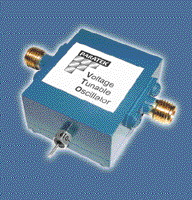 Driven by the VCO market's insatiable need for lower phase noise and wider tuning ranges, a new line of voltage tunable oscillators (VTO) has been introduced with superior performance in these areas. The new VTOs operate at fundamental frequencies with no inherent spurious responses or subharmonics. The oscillators feature fast tuning, low power consumption and software control.
Driven by the VCO market's insatiable need for lower phase noise and wider tuning ranges, a new line of voltage tunable oscillators (VTO) has been introduced with superior performance in these areas. The new VTOs operate at fundamental frequencies with no inherent spurious responses or subharmonics. The oscillators feature fast tuning, low power consumption and software control.
VTO PERFORMANCE
The featured VTO operates at 11 GHz with phase noise at 106 dBc/Hz at 100 kHz offset, as illustrated in Figure 1. The oscillator has a tuning range of 600 MHz (5.4 percent bandwidth), as shown in Figure 2. Other performance specifications include a tuning linearity of 2.8 percent and output power of 0 dBm, with harmonics at 26 dBc and no detectable spurious outputs. In addition, its pushing factor is essentially zero. The new VTOs are packaged in a 1.0" × 1.0" × 0.375" (26 × 30 × 15 mm3 ) housing with SMA connectors for RF output and control input.
|
|
|
PARASCAN MATERIALS
The VTOs are enabled by the patented Parascan™ family of materials. These are voltage tunable dielectric materials, which allow the oscillators to tune over broad frequency ranges through the application of a DC electric field. Parascan materials are ceramic and draw virtually no current (< 5 µA), and thus consume very little power. The key features of this technology in VTO applications are its high Q factors, wide tuning range and linear performance. The availability of this technology in various form factors also enables the design of different topologies. Being passive devices with no discernible noise sources, these tunable dielectric capacitors are excellent candidates for tunable oscillator applications.
The new VTOs are designed to fully exploit the properties of the Parascan materials. Some design considerations and the intended benefits are outlined in Table 1.
|
|
BENEFITS
With pricing comparable to varactor-tuned oscillators, OEMs will benefit from the enhanced performance of the new VTOs. Tuning and frequency range is comparable to YIG oscillators, while spectral purity is approaching that of dielectric resonator oscillators. Switching speed is similar to varactor-tuned oscillators. Synthesizer design is made easy due to the fast linear tuning and the options of low voltage/low current control, sub-harmonic outputs and integral phase locked loop (PLL) amplifiers. The very best features of all competing VCO technologies are equaled or improved in these VTOs.
IN THE FUTURE
The initial VTO product results indicate that additional improvements are achievable in subsequent models. The possibilities include fundamental frequencies in the 20 to 30 GHz range, multiplied outputs up to 40 GHz, tuning ranges beyond 20 percent, better phase noise, higher spectral purity, and surface mount, drop-in and connectorized packaging.
Additional information on the new VTOs and other products including tunable filters, diplexers, delay lines and electronically scanning antennas can be obtained from the company's Web site at www.paratek.com or via e-mail at etrf@paratek.com.
Paratek,
Columbia, MD (443) 259-0140.
Circle No. 301



